Eurasian cave lion may refer to:
- Panthera fossilis , the Middle Pleistocene Eurasian cave lion
- Panthera spelaea , the Late Pleistocene Eurasian cave lion
Eurasian cave lion may refer to:
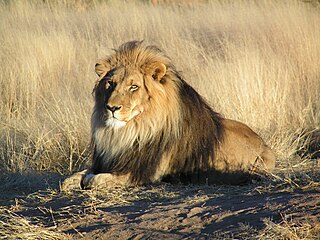
The lion is a large cat of the genus Panthera, native to Africa and India. It has a muscular, broad-chested body; a short, rounded head; round ears; and a hairy tuft at the end of its tail. It is sexually dimorphic; adult male lions are larger than females and have a prominent mane. It is a social species, forming groups called prides. A lion's pride consists of a few adult males, related females, and cubs. Groups of female lions usually hunt together, preying mostly on large ungulates. The lion is an apex and keystone predator; although some lions scavenge when opportunities occur and have been known to hunt humans, lions typically do not actively seek out and prey on humans.

The leopard is one of the five extant species in the genus Panthera. It has a pale yellowish to dark golden fur with dark spots grouped in rosettes. Its body is slender and muscular reaching a length of 92–183 cm (36–72 in) with a 66–102 cm (26–40 in) long tail and a shoulder height of 60–70 cm (24–28 in). Males typically weigh 30.9–72 kg (68–159 lb), and females 20.5–43 kg (45–95 lb).
Panthera is a genus within the family Felidae, it is one of two extant genera in the subfamily Pantherinae, and contains the largest living members of the cat family. There are 5 living species, the tiger, jaguar, lion, leopard and snow leopard and a number of extinct species.
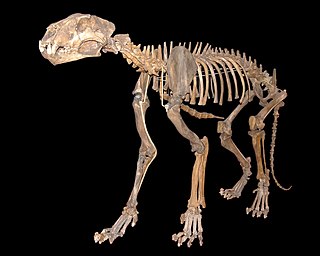
Panthera spelaea, also known as the cave lion or steppe lion, is an extinct Panthera species that most likely evolved in Europe after the third Cromerian interglacial stage, less than 600,000 years ago. Genetic analysis of ancient DNA has revealed that while closely related, it was a distinct species genetically isolated from the modern lion occurring in Africa and Asia, with the genetic divergence between the two species variously estimated between 1.9 million and 600,000 years ago. It is closely related and probably ancestral to the American lion. The species ranged from Western Europe to eastern Beringia in North America, and was a prominent member of the mammoth steppe fauna. It became extinct about 13,000 years ago.

Panthera atrox, better known as the American lion, also called the North American lion, or American cave lion, is an extinct pantherine cat. Panthera atrox lived in North America during the Pleistocene epoch, from around 340,000 to 12,800 years ago. The species was initially described by American paleontologist Joseph Leidy in 1853 based on a fragmentary mandible (jawbone) from Mississippi; the species name ('atrox') means "savage" or "cruel". The status of the species is debated, with some mammalogists and paleontologists considering it a distinct species or a subspecies of Panthera leo, which contains living lions. However, novel genetic evidence has shown that it is instead a distinct species derived from the Eurasian cave or steppe lion, evolving after its geographic isolation in North America. Its fossils have been excavated from Alaska to Mexico. It was about 25% larger than the modern lion, making it one of the largest known felids.

The Pantherinae is a subfamily of the Felidae; it was named and first described by Reginald Innes Pocock in 1917 as only including the Panthera species. The Pantherinae genetically diverged from a common ancestor between 9.32 to 4.47 million years ago and 10.67 to 3.76 million years ago.

The history of lions in Europe is based on fossils of Pleistocene and Holocene lions excavated in Europe since the early 19th century. The first lion fossil was excavated in southern Germany, and described by Georg August Goldfuss using the scientific name Felis spelaea. It probably dates to the Würm glaciation, and is 191,000 to 57,000 years old. Older lion skull fragments were excavated in Germany and described by Wilhelm von Reichenau under Felis fossilis in 1906. These are estimated at between 621,000 and 533,000 years old. The modern lion inhabited parts of Southern Europe since the early Holocene.
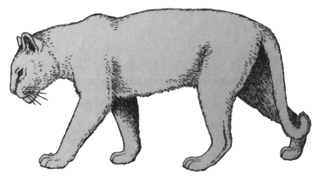
Panthera gombaszoegensis, also known as the European jaguar, is a Panthera species that lived from about 2.0 to 0.35 million years ago in Europe The first fossils were excavated in 1938 in Gombasek, Slovakia. P. gombaszoegensis was medium-large sized species that formed an important part of the European carnivore guild for a period of over a million years. Many authors have posited that the species is the ancestor of the American jaguar, with some authors considering it the subspecies Panthera onca gombaszoegensis, though the close relationship between the two species has been questioned.

Panthera fossilis, is an extinct species of cat belonging to the genus Panthera, known from remains found in Eurasia spanning the Middle Pleistocene and possibly into the Early Pleistocene. P. fossilis has sometimes been referred to by the common names steppe lion or cave lion, though these names are conventionally restricted to the later related species P. spelaea, to which P. fossilis is probably ancestral.
Cave lions are large extinct carnivorous felids that are classified either as subspecies of the lion, or as distinct but closely related species, depending on the authority.
Afghanistan has long been known for diverse wildlife. Many of the larger mammals in the country are categorized by the International Union for Conservation of Nature as globally threatened. These include the snow leopard, Marco Polo sheep, Siberian musk deer, markhor, urial, and the Asiatic black bear. Other species of interest are the ibex, the gray wolf, and the brown bear, striped hyenas, and numerous bird of prey species. Most of the Marco Polo sheep and ibex are being poached for food, whereas wolves, snow leopards and bears are being killed for damage prevention.
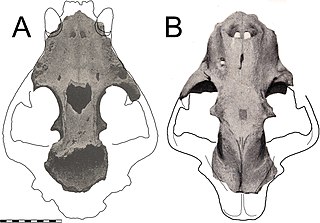
Panthera onca mesembrina is an extinct subspecies of jaguar that was endemic to Patagonia in southern South America during the late Pleistocene epoch. It is known from several fragmentary specimens, the first of which found was in 1899 at "Cueva del Milodon" in Chile. These fossils were referred to a new genus and species "Iemish listai" by naturalist Santiago Roth, who thought they might be the bones of the mythological iemisch of Tehuelche folklore. A later expedition recovered more bones, including the skull of a large male that was described in detail by Angel Cabrera in 1934. Cabrera created a new name for the giant felid remains, Panthera onca mesembrina, after realizing that its fossils were near-identical to modern jaguars’. P. onca mesembrina's validity is disputed, with some paleontologists suggesting that it is a synonym of Panthera atrox.

Denisova Cave is a cave in the Bashelaksky Range of the Altai mountains, Siberian Federal District, Russia. The cave has provided items of great paleoarchaeological and paleontological interest. Bone fragments of the Denisova hominin originate from the cave, including artifacts dated to around 40,000 BP. Remains of a 32,000-year-old prehistoric species of horse have also been found in the cave.

The Petralona Cave a karst formation, is located at 300 m (984 ft) above sea-level on the western foot of Mount Katsika, about 1 km (0.62 mi) east of the village of Petralona, about 35 km (22 mi) south-east of Thessaloniki city on the Chalkidiki peninsula, Greece. The site came to public attention when in 1960 a fossilized archaic human skull was found. The cave had been discovered accidentally only a year earlier (1959) after erosion had left clefts in the rock. "Bejeweled" with impressive stalactite and stalagmite formations and holding an abundance of fossils, the cave soon attracted geologists and paleontologists. After decades of excavations the cave is open to the public and scientific work is documented and presented in an adjacent archaeological museum.

Panthera pardus spelaea, also known as the European Ice Age leopard, is a fossil leopard subspecies which roamed Europe in the Late Pleistocene and possibly the Holocene.
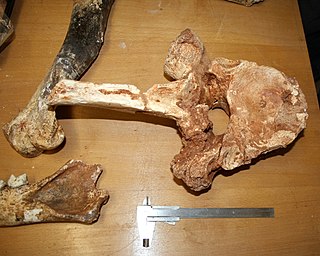
Vrtare Male is a pit cave located near Dramalj, a seaside village in Croatia. Its depth is believed to be 39 metres (128 ft), with around 10 metres (33 ft) submerged. It was first explored in 1966 by the Mountaineering Society Velebit. In 1996, Dragan Pelić, a photographer and spelaeologist from nearby Crikvenica, descended into the cave and found a rare Decapoda specimen, which was confirmed by Croatian spelaeologist Branko Jalžić. This prompted further cave expeditions, starting in 2005, and the establishment of a protected area around Vrtare Male.

The La Garma cave complex is a parietal art-bearing paleoanthropological cave system in Cantabria, Spain. It is located just north of the village of Omoño, part of the municipality of Ribamontán al Monte. The cave complex is noted for one of the best preserved floors from the Paleolithic containing more than 4,000 fossils and more than 500 graphical units. It is part of the Cave of Altamira and Paleolithic Cave Art of Northern Spain World Heritage Site.

The term "maneless lion" or "scanty mane lion" often refers to a male lion without a mane, or with a weak one.
Panthera shawi is an extinct prehistoric cat, of which a single canine tooth was excavated in Sterkfontein cave in South Africa by Robert Broom in the 1940s. It is thought to be the oldest known Panthera species in Africa.
Panthera uncia pyrenaica, also known as the Arago snow leopard or as the European snow leopard, is a subspecies of snow leopard that lived during the Middle Pleistocene in southern France.